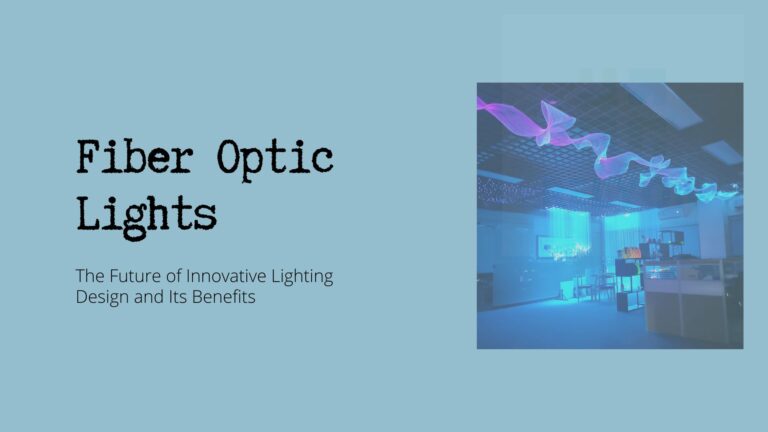Introduction
Lighting has evolved far beyond traditional bulbs, and fiber optic lighting is at the forefront of this transformation. Unlike conventional lighting, fiber optic lights use thin, flexible strands of glass or plastic to transmit light from a remote source, allowing for stunning visual effects and functional applications. Their ability to create vibrant, dynamic, and safe illumination has made them increasingly popular across various industries. From luxurious home décor to large-scale architectural projects, fiber optic lighting is redefining how spaces are illuminated. In this blog, we’ll explore how fiber optic lights work, their types, key benefits, diverse applications, and future trends shaping the industry.
What Are Fiber Optic Lights?
Fiber optic lights are a cutting-edge lighting technology that uses optical fibers to transmit light from a remote source to different locations. Unlike traditional lighting, where bulbs generate light directly, fiber optic cables simply carry the light without producing heat or electricity within the fibers. This makes them incredibly safe and versatile. They are commonly used for decorative, accent, and functional lighting in homes, commercial spaces, and outdoor environments. Key features of fiber optic lighting include flexibility, energy efficiency, and the ability to create mesmerizing lighting effects, making them a popular choice for both aesthetic and practical applications.
How Do Fiber Optic Lights Work?
Fiber optic lights work by transmitting light from a remote source, typically an LED or halogen bulb, through optical fibers. These fibers are made of glass or plastic and guide the light with minimal energy loss, ensuring bright and efficient illumination. There are two main types: end-emitting fibers, which direct light from the tip, creating spotlights or focused beams, and side-emitting fibers, which glow along their length for ambient or decorative effects. Since fiber optic cables do not carry electricity or generate heat, they are much safer than traditional lighting, making them ideal for sensitive environments like museums, pools, and medical applications.
Types of Fiber Optic Lighting
Fiber optic lighting comes in various types, each serving unique purposes. End-emitting fiber optic lights direct light from the fiber’s tip, making them ideal for spot lighting, signage, and intricate decorative accents. Side-emitting fiber optic lights glow along their length, commonly used for architectural lighting, automotive interiors, and artistic installations. Star ceiling fiber optic lights create breathtaking night-sky effects, often seen in home theaters, hotels, and planetariums. Chandeliers and decorative installations crafted with fiber optics bring elegance to luxury hotels, casinos, and event spaces, offering a dazzling, energy-efficient alternative to traditional lighting fixtures.
Benefits of Fiber Optic Lights
Fiber optic lights offer numerous advantages, making them a preferred choice for modern lighting solutions. Energy efficiency is a key benefit, as they consume less power than traditional bulbs, reducing electricity costs. Safety is another advantage since fiber optic cables do not carry heat or electrical current, making them ideal for environments where traditional lighting poses risks. They are also highly durable and require minimal maintenance, as optical fibers do not degrade like conventional bulbs. Their flexibility in design allows for creative installations in various settings. Additionally, they are weather and water-resistant, making them perfect for outdoor landscapes, pools, and fountains. Lastly, fiber optic lighting is eco-friendly, as it minimizes energy consumption and eliminates harmful emissions, contributing to sustainable lighting solutions. These benefits make fiber optic lights an excellent choice for homes, commercial spaces, and large-scale architectural projects.
Applications of Fiber Optic Lighting
Fiber optic lighting is widely used across various industries due to its versatility and unique properties. In architectural and interior design, it enhances spaces with decorative ceilings, feature walls, and luxury lighting installations. Commercial spaces like hotels, restaurants, and shopping malls use fiber optic lights for ambient and accent lighting, creating a sophisticated atmosphere. In the automotive industry, high-end vehicles incorporate fiber optics for dashboard lighting, interior accents, and stylish illumination. Underwater and pool lighting benefit from fiber optics’ waterproof nature, making them ideal for swimming pools, fountains, and aquariums. The medical and industrial sectors use fiber optic lighting in endoscopy, imaging, and precision lighting applications. Lastly, theme parks and entertainment venues rely on fiber optic technology to create immersive lighting effects in attractions, shows, and interactive displays. These diverse applications demonstrate how fiber optic lighting is revolutionizing multiple industries with its efficiency and creative possibilities.
Future Trends and Innovations in Fiber Optic Lighting
The future of fiber optic lighting is being shaped by technological advancements and sustainability trends. Smart fiber optic lighting controlled via mobile apps and IoT integration is making it easier to customize lighting effects remotely. Solar-powered fiber optic systems are emerging as an eco-friendly solution, reducing dependence on conventional electricity. Researchers are also developing advanced materials to improve light transmission efficiency and durability. The demand for customizable and dynamic lighting solutions is growing, allowing businesses and homeowners to create unique atmospheres. Additionally, AI and automation are expected to enhance fiber optic systems, enabling adaptive lighting that responds to environmental changes.
Conclusion
Fiber optic lighting offers a unique blend of energy efficiency, safety, and versatility, making it a game-changer in modern lighting design. Its applications span from architectural and commercial spaces to automotive, medical, and entertainment industries. With its ability to create stunning visual effects while being low-maintenance and eco-friendly, fiber optic lighting is an ideal choice for both businesses and homeowners. As technology advances, innovations like smart controls, solar integration, and AI-driven automation will further enhance its capabilities. Embracing fiber optic lighting today means investing in a sustainable, cutting-edge solution that will continue to redefine the future of illumination.

